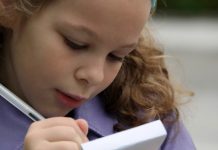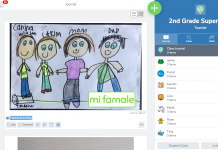
by Linda Sgammato
When parents register their children in the parish religious education program, I often wonder what they are hoping for. For example, when they register their children for kindergarten, parents expect that their children will begin to learn how to read, write, etc. When parents sign up their children for dance classes or to join little league, they hope that their children will learn something about dance or baseball.
So when parents bring their children to the parish for “religion class,” what are they asking of us as catechists?
To Nurture a Relationship
Parents must feel that it is important for their child to know God and to have a life-long relationship with God. Perhaps what they are asking of us as catechists, then, is that we help nurture that relationship.
It is the same—and maybe even a little more intense—for parents of a child with a disability. When the parent of a child on the autism spectrum was asked “What is your expectation for your child in the parish religious education class?” the response was “That my child knows there is a God to pray to.” How we respond to that parent will ease the anxiety of the family who needs to know that this child is accepted and included.
As a catechist you already have everything you need to welcome, support, and catechize children with disabilities. Two of the greatest things you offer each child you meet are your love of the Lord and your desire to share the Good News of Jesus Christ. That you are a joy-filled person who lives the gospel life will be the greatest witness you offer to the child who faces many challenges. How you welcome that child and his or her family does not have anything to do with how much you know or don’t know about the child’s disability. It has everything to do with your openness and willingness to include everyone.
Step by Step
Meeting the needs of the child with a disability takes time and is accomplished step by step.
First, allow yourself enough time to assess and meet the needs of families with children who have disabilities. Be proactive in reaching out to families in various ways. For example, anticipate registration for next year’s program by getting the word out early that your parish desires to meet the needs of children with disabilities. Use the parish bulletin and website to announce your desire to meet the needs of all children in the parish.
Take the time to create opportunities for families to network and support one another within the parish family; this can help parents overcome a sense of isolation.
Second, gain greater insight into the specific disability of the child by having parents complete an individualized information form. Asking particular questions about how the child best learns will assist you in creating a particular environment in which the child can hear and enjoy all that you are sharing. Whether the child is in a self-contained classroom or mainstreamed into the program, you can—with patience and observation—create an environment that speaks to the heart of the child. This is the first step in bringing that child to God. A quiet, sacred environment enables the child to realize that this space is different, that he or she is here to learn and enjoy something different, that this is not a subject to learn but a Mystery to ponder with others.
You might also gain further insight into the child’s specific needs from the IEP form (Individual Educational Plan) used in the child’s regular school program. This form provides information that can help you understand how the school perceives the child and the approach it uses to address the child’s needs. Ask the child’s parents if they would be willing to share their child’s IEP with you. Also ask parents about what they have done at home to familiarize the child with his/her faith.
Third, carefully review and choose appropriate curriculum. The catechetical leader in your parish should be able to direct you to the many excellent resources for special religious education that have been developed in recent years.
Your Gifts and Skills
If you are a catechist working with children with disabilities or feel called to this ministry, keep in mind that a background in special education is certainly a plus. A prime requisite, however, is a heart that is open to being with the child, that sees beyond the disability to the child who is loved by God and family. Being with means journeying with the child toward a greater awareness of God and God’s love.
If you work with a child with disabilities:
* be patient with the child and yourself
* have faith that God knows and loves each child and desires a relationship with each child
* enjoy the relationship you have with the child, knowing that the relationship mirrors relationships throughout the Christian community
* work closely with parents and, on occasion, the child’s regular teachers
* be generous with time and creativity because ready-made materials often are not readily available, and so modifications to available material may be necessary to better serve the child
* be free from anxiety or worry over what the child has/has not learned—trusting, instead, that faithfully presenting the material is the only necessary thing, that the Holy Spirit will do the real teaching
* have a sense of humor that does not take the task (or oneself) too seriously
Your Environment
The environment in which you and a child with special needs meet should be warm, inviting, and comfortable for the child. As much as possible, the environment should include materials and furnishings that are few in number, simple, and attractive. The atmosphere should be quiet, peaceful, and sacred so that it is conducive to learning, worship, mediation, and prayer. Sometimes having simple houseplants which the child can help care for creates a sense of community and belonging.
A child who needs assistance staying focused may enjoy taking care of the environment. Children with ADD/ADHD/LD or mild autism often appear restless, may have difficulty remaining seated, and are frequently distracted. It is difficult for them to wait their turn; they interrupt often; they may have a hard time listening. Quiet, purposeful activities such as watering plants or placing items on a prayer table allows a restless child to engage in movement, practice fine motor control, and contribute to the community.
Inviting children to concentrate on their breathing is a way to help them become quiet and focused. Ringing a soft chime to signal movement to a new activity infuses a space with order and calm. Using a soft tone of voice, speaking slowly, and allowing a few seconds of silence before giving directions can help a child who is easily confused.
To nurture the spiritual life of children, the catechist must do more than transmit information and facts. This is especially true for children who live with physical and intellectual disabilities. Children sense that, despite all that is revealed to us in Scripture and liturgy, God remains a deep mystery.
Applying the Curriculum
Your initial encounters with the child likely will involve trial and error. Before beginning work with a published curriculum (or even choosing a curriculum), observe the child carefully.
Assess a starting point. Bible-based storybooks, games, and crafts with religious themes can provide a starting point for assessment. Use simple crafts, manipulative materials, coloring exercises, worksheets, and storytelling to help bring to the surface what a child already knows or might be capable of doing and learning.
A beginning curriculum for a child with disabilities might include an introduction to the person and life of Jesus through the Infancy Narratives, the Gospel accounts of Jesus’ miracles and parables, stories of Mary and the Apostles, the Bible as the Word of God, and the Church as the gathering of God’s family.
Use multisensory materials and experiences. Textbook curricula for children with disabilities use pictures and icons to present topics of faith to children who cannot read or who are nonverbal. Multisensory materials and experiences form an essential part of the environment. Some children demonstrate acquired knowledge by pointing to an object or picture, placing figures on a flannel board, or working with manipulative materials.
Create experiential learning opportunities. Listening to stories, singing songs of faith, and sharing in communal prayer are activities that offer deep experiential learning. For a lesson on the liturgy, you might bring the chalice and cruets—articles the child normally sees at Mass—into the environment for the child to see and touch.
Intellectual Disabilities
Children with intellectual disabilities mature at a slower rate than what is considered the average. As a result, they experience difficulties with learning and social development.
Intellectual disabilities can be mild to severe, depending on the cause of the disability. Children with intellectual disabilities develop in the same way as persons who are not intellectually delayed, but at a slower rate. They reach a lower overall level of functioning. Children with Down syndrome are included in the group of persons with intellectual disabilities.
For the child with limited mental ability, experiences of community, acceptance, and patience are of much greater value than any textbook or factual information we might share. A child who is unable to remember facts will never forget what it feels like to be a loved, accepted, and treasured member of Christ’s family, the Church.
Here are some approaches you can take to meet the needs of the child who is intellectually challenged.
* Expand the child’s horizons. Rather than talking about the details of your parish church, take the child to see the inside of the church. Visit the sacristy and show the child the articles used during Mass. Introduce the child to the pastor rather than just explaining who the pastor is and what he does.
* Engage the child’s senses. Provide short sessions and engage as many senses as possible to hold attention. When using a textbook, focus on a particular picture and teach around what the picture is portraying.
* Keep things simple. Begin with simple terminology that a child can understand.
| SIMPLE | ADVANCED |
| God’s house | Church |
| Jesus’ bread, God’s holy bread | Communion |
| Jesus’ cup | chalice |
| Jesus’ table | altar |
| Jesus’ friends | Apostles |
| God’s holy meal | Mass |
* Remain flexible. There will be days when all a child can handle is to play quietly or listen to a story. On those occasions, model God’s unconditional love simply by being with the child in a loving, supportive manner.
As you meet the challenge of assisting a child with disabilities, expect your own faith to grow. You will surely discover the gifts of those very persons whom Jesus, in his earthly ministry, repeatedly touched through his kindness and graciousness.
Did You Know?
* Almost all children with disabilities can be prepared in a simplified manner to receive the Sacraments of Eucharist and Confirmation.
* Although all children are encouraged to learn and pray the basic prayers (Our Father and Hail Mary), memorization of these prayers is not a requirement for receiving the Sacraments. Many children with disabilities have great difficulty memorizing things. For some children and parents, requiring such memorization causes anxiety and stress.
* The timing and frequency of instruction can be adapted to a child’s particular needs.
* A catechist for children with disabilities does not need a background in special education. Textbooks and methodologies are now available to help catechists with students who have special needs.
Resources
Welcome One, Welcome All (available from the Institute for Pastoral Initiatives, ipi.udayton.edu)
Sacramental Preparation for Individuals with Special Needs (Loyola Press, loyolapress.com/special-needs)
Signing the Scriptures: A Starting Point for Interpreting the Sunday Readings for the Deaf (Liturgical Training Publications, ltp.org)
National Catholic Partnership on Disability (ncpd.org, works collaboratively to ensure meaningful participation of people with disabilities in all aspects of the life of the Church and society)
Linda Sgammato served as the Director of Early Childhood and Special Religious Education for the Archdiocese of New York Catechetical Office.
Copyright 2014, Bayard, Inc. All rights reserved. This article is protected by United States copyright and other intellectual property laws and may not be reproduced, rewritten, distributed, redisseminated, transmitted, displayed, published or broadcast, directly or indirectly, in any medium without the prior written permission of Bayard, Inc.
This article was written by the Catechist Staff and appeared in Catechist magazine, July 2014.
Image Credit: MIA Studio/Shutter Stock 608275256




